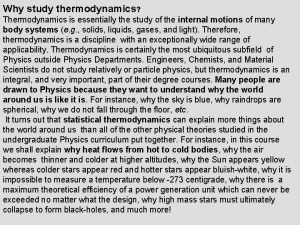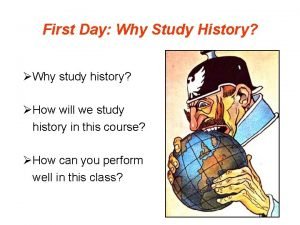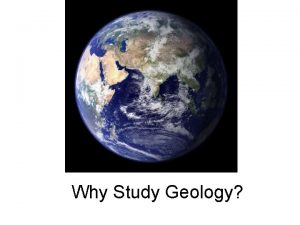Introduction to World History Why Study World History



















- Slides: 19

Introduction to World History

Why Study World History? 1. Understand the significance of the past to our own lives and to our society 2. Distinguish between important and the inconsequential 3. Perceive past events and issues as people of their time experienced that period/event 4. Appreciation of the events that have taken place throughout human history 5. Curiosity about anything is satisfied: • All subjects& interests tied to world history • Play “Indiana Jones” 6. Avoid crazy conspiracy theories!

Housekeeping • World History involves a lot of controversial topics • Everything from Human Evolution to the Holocaust will be covered • In this class, we will keep-in-mind how historians view different topics and events in a fair and open-minded approach • We will also attempt to look at all sides of an issue (not just “the winners”) • In addition, “BCE” will designate “Before Christian Era” while “CE” will designate the “Christian Era” (Year Zero) • The textbook uses “BC” (Before Christ) and “AD” (“After Death”) • If you prefer “BC” and “AD” for your personal notes, that is fine as well

Chapter 1: The First Humans Prehistory-3500 BCE

Pre-History: • Era of History before the invention of writing • Written records mark the “beginning” of history • Evidence from the prehistoric period comes from the fields archaeology and anthropology

The Ice Age

Australopithecus: The First Modern Ancestor • Earliest “humanlike” ape creatures existed in eastern and southern Africa • • Approximately 4 million years ago About 4’ in height Discovered by Donald Johanson The first of the various hominid species • Recently as of 2007, it is believed that the evolution of humans was less like a tree and more that of a shrub • Hominids spread out of Africa and across the world • Many became extinct due to various causes


Notable Hominids • Homo Erectus • Species emerged around 1. 5 million years ago and developed larger tools • Homo Habilitus • Homo Sapiens • Developed around 250, 000 years ago and the ancestor of the Neanderthal and Homo Sapiens • Neanderthal • Developed from Homo Sapiens; flourished between 100, 00030, 000 BCE throughout Europe and SE Asia • First believed to bury their dead and created clothing from killed animals


• Cro-Magnons • Developed very sophisticated tools • Homo Florensus (“Hobbit”) • Homo Sapiens • our species; rose to the top of the evolutionary chain and became the top predator during the end of the Ice Age • Believed to have killed off dozens of species including the Neanderthal, wooly mammoth, and wooly rhinoceros • Superior brain allowed for the development of sophisticated tools, planning for mass hunting parties and eventually migration across the globe

Migration Pattern

Paleolithic Age • Approximately 2, 500, 000 to 10, 000 BCE • Period humans used simple stone tools and relied on hunting and gathering for daily food • Developed better tools including the spear and bow and arrow • Nomadic • Move from place to place • Followed the great herds • Survival • Both acquired food with majority of women finding nuts and berries and men hunting large game • Found shelter in caves and learned how to use fire

Examples of Stone Tools

Art Emerges • Cave paintings of large animals • Religious or beautification of surroundings • Remarkable because first time in human history humans modified their surroundings • Many are realistic depictions instead of “stick figures”

Neolithic Revolution • After the end of the last Ice Age • 8, 000 to 4, 000 BCE • Shift from hunter-gatherers to domestication of animals and the growing of food on a regular basis • Agriculture was not spontaneous • Began in the Middle East and spread over the course of thousands of years • Humans had greater control over their environment and gave up nomadic ways • Growing of crops led to more permanent settlements

Neolithic Settlements • Appeared in Europe, India, Egypt, China, and Mesoamerica • Jericho: located in Palestine and earliest known city • Catal Hüyük: located in Turkey with large walls for thousands of people; major trading center for crafts • Religion takes a greater role in cities

Results of the Revolution and End of Period • Agriculture and domestication of animals led to permanent settlements • Emergence of trade with other settlements • Development of artisans and specialized jobs • Use of metals marked the end of the Neolithic Period • Rise of the Bronze Age (3, 000 to 1200 BCE)

Emergence of Civilization • Cultures develop unique to each society • Civilization: a complex structure where large numbers of human beings share a number of common elements • Rise of Cities • Governments emerge to manage cities • New social structures based upon economic power • Writing a prominent feature • Like agriculture, not everyone “learned” it • Mesopotamia, Egypt, India, China, and Mesoamerica lead the way
 Why why why why
Why why why why Dont ask
Dont ask Why study history a level
Why study history a level World history and geography final exam study guide
World history and geography final exam study guide World history final exam review
World history final exam review World history semester 1 final exam study guide answers
World history semester 1 final exam study guide answers Us history semester 1 final exam study guide answers
Us history semester 1 final exam study guide answers Ap world history chapter 25 africa and the atlantic world
Ap world history chapter 25 africa and the atlantic world Dangerous world tour history world tour - hockenheimring
Dangerous world tour history world tour - hockenheimring Ecological study vs cohort study
Ecological study vs cohort study Retrospective cohort study vs prospective cohort study
Retrospective cohort study vs prospective cohort study Critical examination in method study
Critical examination in method study Study less study smart
Study less study smart Study to study
Study to study Differentiate between time study and motion study
Differentiate between time study and motion study Differentiate between time study and motion study
Differentiate between time study and motion study Pressure is state function or path function
Pressure is state function or path function Financial markets and institutions chapter 1
Financial markets and institutions chapter 1 Biotechnology
Biotechnology Alasan memilih metode penelitian
Alasan memilih metode penelitian





































